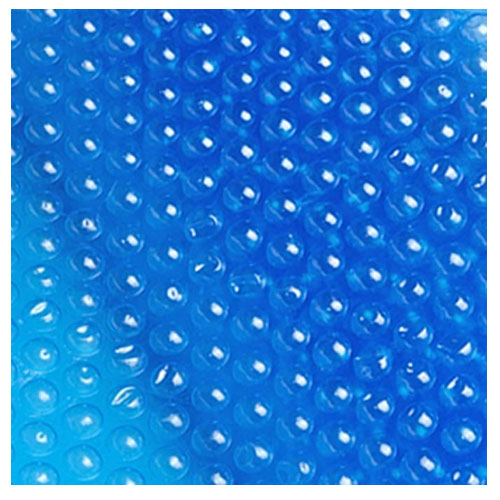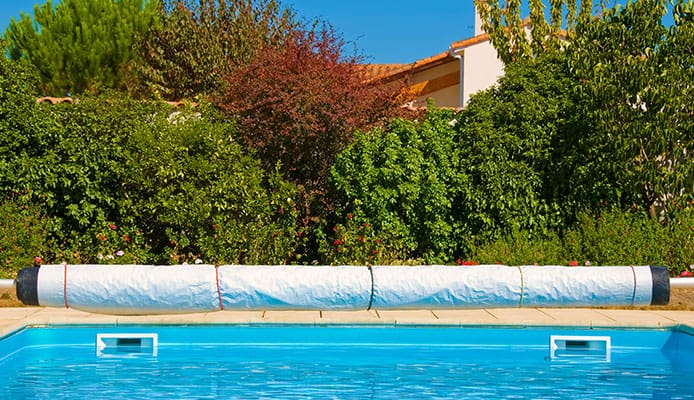
With all the joys that a swimming pool brings comes a number of costs to keep in a tip-top condition. One of the biggest running expenses for pool owners is often water heating. But what if there was a way to reduce heater use and harvest sunlight to warm the water? A solar pool cover does exactly that.
Thanks to its plastic film that consists of countless air bubbles, the best swimming pool solar cover works as an insulating layer on the water surface and prevents heat loss. Not only this, but it also lets a substantial amount of sunlight through, effectively helping raise the water temperature.
Finding a solar pool cover involves knowing the right type, size, thickness, and color. Our buying guide and solar pool cover reviews will help you choose a top rated swimming pool solar cover that will keep the water warm and even extend your pool season.
OUR TOP PICK
Intex Solar Pool Cover
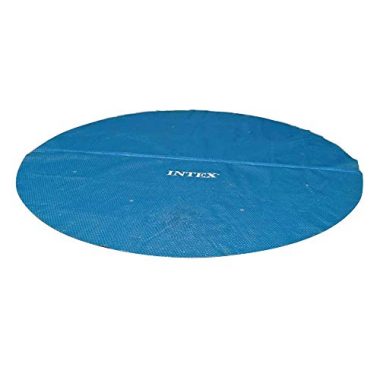
- Stand Out Features - Why We Love It
- Drain holes in the surface prevent water accumulation
- Blue bubbles reduce evaporation by 95%
- Reusable carry bag for convenient storage
- Lightweight (2.6 lbs) for easier setup and removal
Pool type: Above ground
Shape: Round
Dimensions: 12 feet (diameter)
Color: Blue
Warranty: 1 year
EDITORS CHOICE
Splash Pools Round
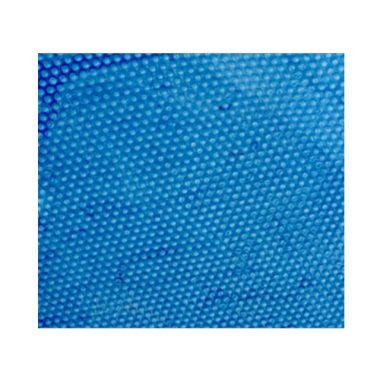
- Stand Out Features - Why We Love It
- Efficient at keeping debris out of the water
- Raises the pool temperature by 15°F
- Works with both in-ground and above ground pools
- Several different size options available
Pool type: Above ground and in-ground
Shape: Round
Dimensions: 18 feet (diameter)
Material: Polymer plastic
Color: Blue
BEST VALUE
Bestway Solar Pool Cover
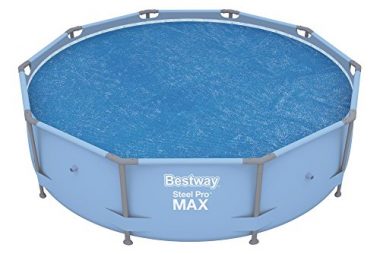
- Stand Out Features - Why We Love It
- Surface has holes to keep water from accumulating
- Perfect fit for smaller 10-foot pools
- Carry bag with insert for easier storage
- Retains heat well and significantly reduces debris
Pool type: Above ground
Shape: Round
Dimensions: 10 feet (diameter)
Color: Blue
MidWest Canvas Above Ground
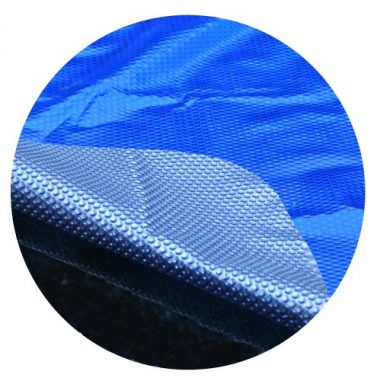
- Stand Out Features - Why We Love It
- UV-protected material for greater durability
- Blue and silver combination can retain heat well
- Thicker than most covers (8 millimeters)
- Generous five-year warranty
Pool type: Above ground
Shape: Round
Dimensions: 21 feet (diameter)
Thickness: 8mm
Color: Blue on silver
Warranty: 5 years
Blue Wave NS520 14-mil
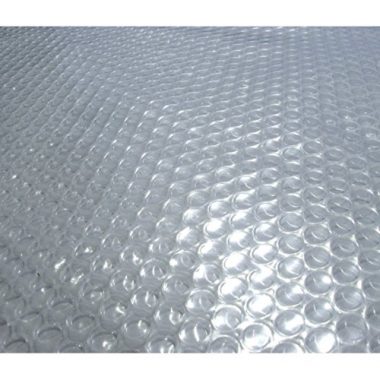
- Stand Out Features - Why We Love It
- Clear color for greater heating efficiency (up to 15 degrees F)
- Countless bubbles prevent heat loss during the night
- Plastic is highly resistant to UV rays and pool chemicals
- Blue Wave makes it easy to customize for unusual pool shapes
Pool type: In-ground
Shape: Rectangular
Dimensions: 32 x 16 feet
Thickness: 14 mil
Material: UV-protected plastic
Color: Clear
Warranty: 6 years
Pool Mate 2040RS-8SBD BOXPM Deluxe
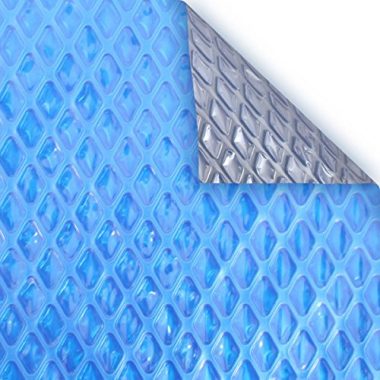
- Stand Out Features - Why We Love It
- Aluminum underside layer traps more heat
- Up to 14.6% better than average heat retention
- Stable and UV-resistant materials used
- Three different sizes available
Pool type: In-ground
Shape: Rectangular
Dimensions: 20 x 40 feet
Thickness: 12 gauge
Material: Plastic, thin aluminum
Color: Blue on silver
Warranty: 5 years
Sun2Solar Blue Rectangle
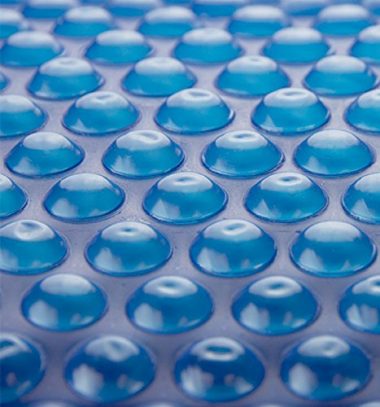
- Stand Out Features - Why We Love It
- Great for both pool types (in and above ground)
- Thick bubbles give a high degree of heat retention
- Efficient at preventing water loss through evaporation
- Safe for cutting to make a better fit
Pool type: Above ground and in-ground
Shape: Round
Dimensions: 24 feet (diameter)
Color: Blue
Harris Rectangle
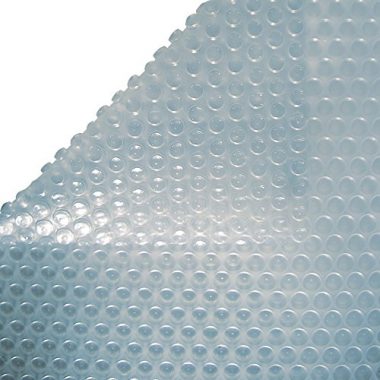
- Stand Out Features - Why We Love It
- Affordable solution for larger pools
- Clear color lets more sunlight through
- Heats water by up to 15°F
- Generous 7-year warranty period
Pool type: In-ground
Shape: Rectangular
Dimensions: 16 x 24 feet
Thickness: 12 mil
Color: Clear
Warranty: 7 years
Thermo-Tex 2831224
- Stand Out Features - Why We Love It
- Polymer construction resists damage from UV and chlorine
- Extends pool season by up to 2 months
- Greatly reduced chemical and pool heating costs
- Lightweight design makes setup much easier
Pool type: In-ground
Shape: Rectangular
Dimensions: 12 x 24 feet
Material: UV-stabilized polymer
Color: Blue
Warranty: 3 years
In The Swim 16-mil
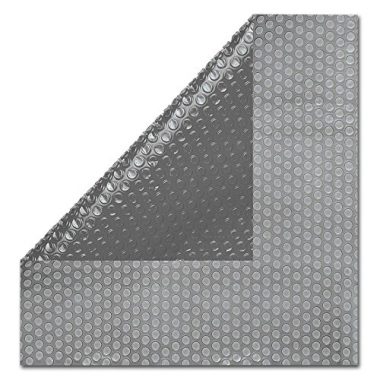
- Stand Out Features - Why We Love It
- Large range of sizes to fit any pool
- Aluminum bottom improves heat retention
- Keeps debris from getting in the water
- 8-year warranty (longest on the list)
Pool type: In-ground
Shape: Rectangular
Dimensions: 16 x 32 feet
Thickness: 16 mil
Material: Polyethylene
Color: Clear
Warranty: 8 years
How to Choose The Best Solar Pool Cover – Buying Guide
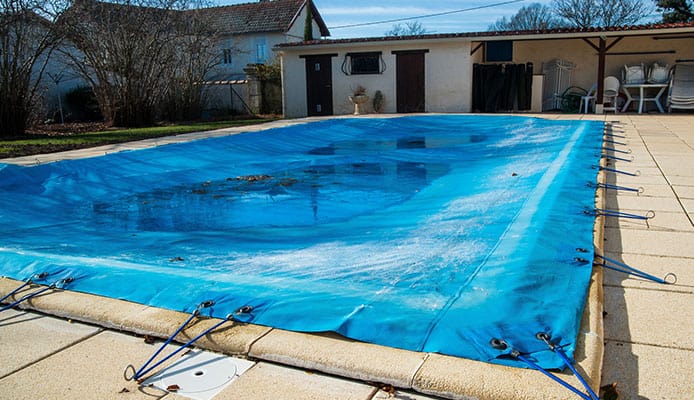
Types of Solar Covers
Even though most of us think of bubble covers when solar covers are mentioned, there are actually three different types of solar pool covers that use the sun’s energy to heat the water. These include a bubble cover (solar blanket), solar rings, and liquid pool covers.
Solar blankets: This is the type that looks like a large sheet of bubble wrap. Those air bubbles serve a dual purpose – they help the cover float on the surface and prevent heat loss and evaporation from the water.
These covers for pools come with a varying degree of thickness and in plenty of different sizes so you can find a model that fits your pool. A thicker cover will be more durable and retain heat better, but the tradeoff is that it’s more difficult to handle (set up and remove).
As for the size, solar blankets pools come in all the standard pool dimensions, regardless if you have a round or rectangular pool. If you can’t find your size or your pool has an unusual shape, an advantage is that you can trim them so they fit properly.
Solar rings: The way these rings work is exactly the same as solar blankets, but the design is a bit different. Basically, solar rings are cut out circles of the blanket material that you throw on the water surface.
They are limited in size (don’t cover the whole pool), so their performance will be limited too. However, they can stay in the pool the whole time, and you can put them in and remove them more easily.
Liquid solar cover: Compared to a physical cover, a liquid cover is much more convenient to use. You pour it over the water and it forms a thin film on the surface.
This film works as a barrier that helps pool water warm up and prevents evaporation, but you can still take a dip when you want. As a downside, these solar pool covers offer no debris protection and you’ll have to add the solution often for it to work (usually lasts a month).
Pool Size
Pool size is one of the most important considerations if you want the cover to be as efficient as possible. As you probably know, it should cover the whole water surface, neither too big nor too small.
A cover that is too big is going to be very difficult to handle. It will also be much easier for the wind to pick it up and move it. On the other hand, a cover that is too small won’t be as efficient. Obviously, it won’t heat the water well, and the uncovered areas will lose heat and evaporate.
For this reason, you must know the pool dimensions before buying a cover. This way you’ll be able to get the exact size or a model that is just slightly larger so you can easily trim it afterward.
Pool Shape
Solar pool covers are mainly sold in one of three shapes: rectangular, round, or oval. Above ground pools are generally round in shape (due to their construction), so round covers are usually made with this type of pool in mind. On the other hand, most in-ground pools are rectangular and have solar pool covers in a matching shape.
But what if you have a non-standard pool? In this scenario, you’ll have two options. You can get several smaller covers for the pool – this is less expensive but also less efficient. As an alternative, you can get a larger pool cover and then cut it. This is pretty easy to do, but it might be costly because you’ll throw away a lot of material.
Thickness
Thickness plays a big role in how effective your solar cover is going to be. However, getting the thickest cover won’t always be the best solution.
Of course, it’s true that a thicker solar cover is more effective at keeping that heat locked in. It magnifies the sunlight better before it reaches the water, adding more heat.
Also, a thicker cover will insulate the pool water better – there is more material to block the heat from escaping. Another benefit is that a thicker material also means more weight, so the pool blankets will be more secure and stable in stronger winds (won’t get blown away).
On the other hand, there are some downsides to the extra thickness too. The product will be more difficult to roll up and store due to its weight. Also, they are generally more expensive than thinner models. While it’s usually better to go for a thick solar cover, keep all this in mind before making your choice.
You might also like: How To Dive Into A Pool
Color: Clear vs Blue Solar Pool Cover
While for most other products color is a matter of aesthetic choice, a solar cover color can actually make a vital difference to how it performs. Most solar blankets for pools are either clear or blue, but you can also find dark models or various combinations.
Clear pool cover: It allows almost all light through, magnifying it in the process. It doesn’t absorb much heat, so the water temperature will rise quicker. On the other hand, it’s not as efficient at retaining heat, and the unfiltered UV rays damage the chemicals in the pools.
Blue pool cover: This type is somewhere in the middle between heating water and keeping it warm. It lets a substantial amount of sunlight through, but it can also block much of the heat loss and maintain temperature. It also absorbs a portion of UV rays so they don’t degrade the chemicals.
Dark pool cover: Darker colors are best for heat retention (dark blue, grey, silver, black). If the water is warm, this cover will be the most efficient to prevent heat loss. Unfortunately, they absorb most of the sunlight so the water underneath them won’t get warmed up easily.
Warranty Coverage
With so many terms and conditions, the world of warranties can be a difficult one to understand. These apply to various aspects and tell you when the warranty is valid and when it isn’t. Unfortunately, most swimming pool solar covers come with this type of limited warranty that covers you only in certain scenarios.
For this reason, you must check the provided warranty for each product. Even if a model offers 7 or 8 years of coverage, this won’t mean much if it only covers material defects in perfect conditions.
On the other hand, some models offer full coverage for the first few years. This means that even if you have a tear or some other damage, they will replace the product. This is a big plus as it gives a sense of security, especially if you need a larger solar blanket pool cover. Also, checking the product reviews can give you an idea and show you what you can expect in the long run.
FAQs
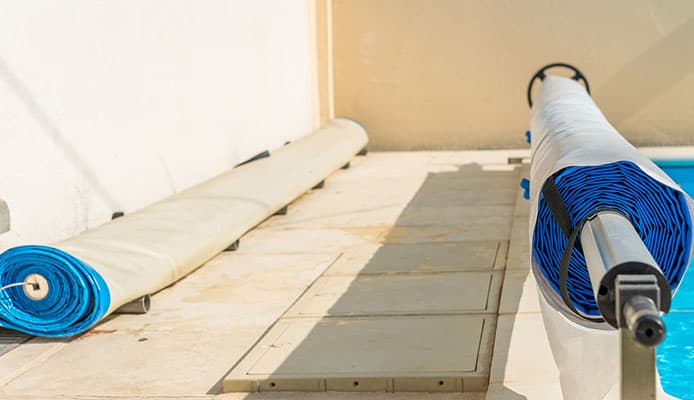
Q: What Is A Solar Pool Cover?
A solar pool cover is a plastic sheet that helps heat the pool water and keeps it warm. It usually has lots of air bubbles (like a bubble wrap) that insulate the water, prevent cooling down, and reduce evaporation. With this pool cover solar energy is used to heat your pool instead of a traditional pool heater. Overall, it’s a great and affordable way to raise and maintain pool temperature.
Q: What Are The Main Benefits Of Using A Solar Pool Cover?
The benefits of solar pool covers include water heating, retaining the sun's heat, preventing evaporation, and keeping debris out. The plastic layer lets sunlight through to warm up the water, while the air bubbles maintain the temperature and work as a barrier to prevent drying up. Additionally, this physical barrier will also keep your pool clean from dirt and debris.
Q: What Are Different Types Of Pool Covers?
As we’ve mentioned earlier, there are three different types – bubble covers, solar rings, and liquid covers. Solar bubble covers are the most common (and efficient), while the other two have some limitations. Solar rings will only cover a limited area, while a liquid pool cover needs to be applied frequently to work.
Q: Are Solar Pool Covers Safe?
Yes, a solar pool cover is perfectly safe to use on the pool water. However, you should be aware of its limitations. This is not a safety cover, meaning nobody can walk on it without falling in (even kids or pets). Also, make sure that when you use solar blankets pools remain empty. Otherwise, somebody might get trapped underneath the blanket.
Q: How Does A Solar Pool Cover Work?
A solar pool cover resembles a see-through bubble wrap, just made of much better materials. The transparent surface lets sunlight through to heat up the water. On the other hand, the bubbles are filled with air that works as insulation and prevents heat from leaving the water. As a bonus, a pool solar cover greatly reduces evaporation too.
Q: How Well Do Solar Pool Covers Work?
It depends on the weather conditions and what you expect from the cover. If the weather is cloudy and cold, the cover won’t be able to do much in terms of heating. Still, many people use it to retain the heat generated by a heater, and it can really shine in this scenario even in bad weather.
Q: How To Install A Solar Pool Cover?
This is not hard to do – it’s just a matter of fitting the cover well. Here’s what you need to do:
- If you don’t know the exact pool dimensions, measure it
- If an exact cover size doesn’t exist, go with a slightly larger cover
- Mark the pool outline on the cover and cut off the excess material (it needs to cover the whole surface)
- Place the cover in the swimming pool with the bubble side facing the water
Q: How To Clean A Solar Pool Cover?
Cleaning the cover properly before storing it will significantly improve its durability. You can do this by following a few easy steps:
- Remove the debris from the cover surface (use a hand skimmer or push it into the pool filter)
- Remove the cover and put it on a soft surface (grass for example)
- Hose off the pool chemicals and other dirt (algae can often be removed this way too)
- If you need to scrub it, make sure you only use a soft cloth or brush
- If water is not enough, you can use a mild detergent or a mild bleach solution
- If some of these cleaners were used, make sure to rinse the cover properly afterward
- Leave to dry completely before storing to avoid mold and smells
Q: How To Cut A Solar Pool Cover?
This is very simple to do, and you can do it with your regular household scissors (as long as they’re sharp). As we said, you need to know the swimming pool dimensions, mark them on the cover and follow the marked lines. Keep in mind that it’s smart to cut a bit less initially and do small corrections, as this will allow you to find the exact fit.
Q: How To Keep A Solar Pool Cover From Blowing Off?
The simplest way to do this is to add some weight to the cover surface. If the cover doesn’t have drain holes, you can pour a small amount of water over it with a hose (0.5 inches will do the job). If this isn’t possible, you can pour water into plastic bags and put them around the edges.
Q: How To Store Solar Pool Cover?
You should store the solar cover in a dry place, away from sun's heat or any other heat source. Before you store it, make sure you clean it properly and it’s fully dry. It’s even better if you put it in a box or a storage bag (included with some models). If it’s on a reel, you can leave it there but make sure it’s covered and protected.
Globo Surf Overview
Solar bubble pool covers are a great solution for keeping your pool water warm without spending a fortune on heaters. A pool solar blanket requires only sunlight to work, and just a few sunny days are enough to raise the temperature by 10 to 15 degrees Fahrenheit.
On top of this, both inground pool covers and above ground pool covers prevent water evaporation too, so you get a double benefit. Hopefully, our buying guide helped you find the best solar pool cover that will keep your pool warm for many seasons to come.


